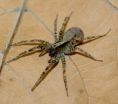(Press-News.org) Athens, Ga. – A University of Georgia researcher studying invasive ladybugs has developed new models that help explain how these insects have spread so quickly and their potential impacts on native species.
In recent years, some people have noticed swarms of ladybugs amassing in the fall, even infesting their homes. These are Asian lady beetles, insects native to eastern Asia, introduced to the U.S. as a biocontrol for aphids and have since spread throughout the country and into Canada. When he found the beetles in his own home, Assistant Research Scientist Richard Hall, of the UGA Odum School of Ecology, was motivated to learn more about them.
Hall knew that the Asian lady beetle had only recently, in 2004, arrived in his native England, and is already found all over the U.K. Data collected as part of a citizen science effort based at Cambridge University shows it to be one of the fastest documented invasions ever by an insect. He also knew that in the U.S., the Asian lady beetle has excluded many indigenous ladybugs from parts of their original range.
"I wanted to know how this insect could have invaded the U.K. so quickly," Hall said. "And I also wanted to know what the impacts on native species are likely to be." He has just published two new papers that explore these questions in the journals Biology Letters and Ecology.
"What makes this insect a good biocontrol also makes it a good invader," Hall said. "It has multiple generations per year, compared to just one for native British ladybugs. It tolerates a wide range of environmental conditions. And it has a generalist diet—it likes aphids, but it will also eat other ladybugs. In other words, it eats its own competition."
Hall explained that when an invader expands into an open niche, with no native competitors present, invasion happens faster than if a competitor was already there; native competitors slow the rate of invasion. If an invader can eat the native competitor, however, it not only gains a source of nutrition but also reduces competition for lower-level food resources. If the resource benefit is a good one—the native competitor is a rich source of nutrition—the invader that eats its competition can invade even faster than if there were no competition at all. This may be the case with the Asian lady beetle.
Hall developed a model, published in the current issue of Biology Letters, that explains his findings and predicts that invasive species that feed on both lower-level food sources and species that compete for these same food sources will be more successful, and spread faster, than those that only feed on lower-level sources.
Predicting the potential impacts on native species was more complicated.
Native ladybugs in the U.K. have a natural enemy, a parasitoid wasp that lays eggs in adult ladybugs. When the eggs hatch, the larvae emerge and use the ladybug as both food and protection against predators. These wasps are now parasitizing Asian lady beetles in the U.K.
In a paper in the February 2011 issue of the journal Ecology, Hall described a model he developed to explain the interaction between the three species—invasive ladybug, native ladybug and the parasitoid wasp that is their common predator—and predict effects.
"The shared natural enemy changes the equation," said Hall. "There are a couple of possible outcomes. If the wasp prefers to lay its eggs in the invader, that might allow the native species to persist. But the invader may turn out to be a 'sink' host—the wasps may have less reproductive success on the invasive ladybugs, since they didn't co-evolve. In that case, you could lose both the native ladybug and its native predator, the ladybug due to predation and competition by the invader and the wasp due to reproductive failure."
Hall said that both models could be applied to other species where the invader preys on, as well as competes with, a native species. "It is important to take into account the effects of a natural enemy on that interaction in order to avoid incorrect predictions about which species will persist," he said. "And accurate predictions are crucial for developing successful management strategies."
### END
UGA studies explain spread of invasive ladybugs
2011-04-02
ELSE PRESS RELEASES FROM THIS DATE:
US CDC issues updated bloodstream infection prevention guidelines
2011-04-02
New guidelines, released by the Centers for Disease Control and Prevention (CDC) and the Healthcare Infection Control Practices Advisory Committee (HICPAC) outline steps to eliminate bloodstream infections in patients with intravenous catheters, which are among the most deadly and costly healthcare-associated infections (HAIs).
The document, titled "Guidelines for the Prevention of Intravascular Catheter-Related Infections" will be published in its entirety in a special supplement to the American Journal of Infection Control. The Journal will also present a video roundtable ...
Proposed Legislation Would Require Alcohol Monitors for DWI Probation
2011-04-02
Senate Bill 232 -- introduced in November by state senator Jane Nelson and currently being debated by the Criminal Justice Committee of the Texas State Senate -- recommends that every person put on probation following a conviction of driving while intoxicated (DWI) wear an alcohol-sensing monitor.
The most common of these monitors is known as a secure continuous remote alcohol monitor (SCRAM). SCRAM bracelets -- manufactured by Alcohol Monitoring Systems, Inc. -- have gained notoriety due to high-profile DWI cases involving Hollywood celebrities. They are the most common ...
Skywalker ensures optimal communication between neurons
2011-04-02
"I hope that unraveling the way Skywalker works will not only teach us more about the way neurons communicate with each other but will also lead to new diagnostics and therapies for neurological diseases such as Parkinson's," says Verstreken.
Communication between brain cells
Brain disorders take a major toll on society. More than 8% of the population in the West depends on analgesics. Twenty per cent suffers from a mental disturbance and the number of people suffering from the effects of neurological diseases is estimated at 1 billion. Many of these problems are caused ...
When food is scarce, hungry female spiders alter mating preferences
2011-04-02
New research from the University of Cincinnati provides food for thought.
The research examined how short-term and long-term hunger affected mate selection and aggression in female wolf spiders (Schizocosa ocreata) commonly found in the eastern United States and Canada. These female spiders are potentially aggressive and cannibalistic when approached by a courting male.
The research is published in the April 2011 print issue of the journal, "Animal Behavior." It was carried out by George Uetz, UC professor of biology, and former UC doctoral student Brian Moskalik, ...
EOBR Rule Aims to Keep Truckers Honest
2011-04-02
More than half of the commercial vehicle drivers who responded to United Safety Alliance, Inc.'s online survey admitted to deliberately violating federal Hours of Service (HOS) regulations. Those regulations aim to keep highways safe by limiting driving time so commercial vehicle drivers get enough rest.
Currently, HOS compliance is monitored through paper logs and supporting documentation such as toll receipts. However, paper logs allow for falsification. For that reason, the Federal Motor Carrier Safety Administration (FMCSA) is looking to shift to an automated means ...
Short rotation energy crops could help meet UK's renewable energy targets
2011-04-02
Planting short rotation energy crops on England's unused agricultural land could produce enough biomass to meet renewable energy targets without disrupting the food industry or the environment, according to research led by Professor Gail Taylor from the University of Southampton.
The study, funded by the UK Energy Research Centre (UKERC), is a rare investigation into energy crop supply which looks at the potential of planting short rotation coppice (poplar and willow) in England, taking into account social, economic and environmental constraints. It found that with efficient ...
Slipping and Falling on an Icy Connecticut Sidewalk
2011-04-02
January 2011 was the snowiest January that Connecticut has seen since records were first kept in 1905. While one would expect snow and ice accumulation to impact commute times, such accumulation also has had impact on sidewalks, making outside entrances to businesses and houses slippery and dangerous. In fact, according to the Brookfield Patch, snow and ice-related accidents are unusually high this year. Tom Rizzo, spokesman for the Westchester District of the United States Postal Service, also told the Yorktown Patch that there have been 57 accidents due to slips and falls ...
Proposed Federal Immigration Law Promotes Enforcement, Reduces Opportunity
2011-04-02
Federal legislation proposed by Republican Senator Orrin Hatch seeks to force local law enforcement agencies to further assist federal immigration policy or lose funding. Senate Bill 332, the Strengthening Our Commitment to Legal Immigration and America's Security Act, also eliminates the diversity visa, an immensely popular program that allows for 50,000 lottery-based visas every year. Several other provisions involving exit procedures, welfare benefits and drug crimes round out the wide-ranging bill. But some commentators are already calling the effort a political ploy ...
When washing becomes a compulsion
2011-04-02
Obsessive-compulsive disorder is often diagnosed too late in children and adolescents. In the current issue of Deutsches Ärzteblatt International (Dtsch Arztebl Int 2011; 108: 173-79), Susanne Walitza and her colleagues point out that appropriate early recognition and treatment can positively affect the course of the disease.
Compulsive washing, the most common obsessive-compulsive manifestation among children and adolescents, is present in up to 87% of all patients; other common types are compulsive repetitive behavior and checking, and obsessive thoughts of an aggressive ...
Sleeping through danger: the dormouse approach to survival
2011-04-02
The dormouse in Alice in Wonderland was well advised to stay asleep – especially as doing so did not prevent it from taking a full part in the tea-time conversation. Dormice in Europe spend about eight months of the year asleep and are extremely safe during this extended period, with almost all of them surviving the winter. This result comes from a study of dormouse survival rates in Austria, the Czech Republic, England, Germany and Italy.
Karin Lebl was a PhD student in Ruf's group. Together with collaboration partners in these countries, she examined how the survival ...

